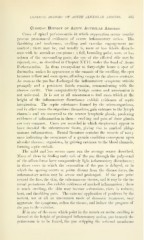Page 487 - My FlipBook
P. 487
CLINICAL HISTORY OF ACUTE ALVEOLAR ABSCESS. 485
Clinical History of Acute Alveolar Abscess.
Cases of apical pericementitis in which suppuration occurs usually
present pronounced evidences of severe inflaniniatory action. The
throbbing and tenderness, swellino- and vascular engorgement are
marked ; there may be, and usually is, more or less febrile disturb-
ance with its attendant symptoms ; a full, bounding pulse, more or less
oedema of the surrounding parts, the eye of the affected side may be
injected, etc., as described in Chapter XVII. uuder the head of Acute
Pericementitis. In from twenty-four to forty-eight hours a spot of
fluctuation makes its appearance at the summit of the swelling, the spot
becomes yellow and soon opens, affording escape to the abscess contents.
As soon as the pus has discharged the inflammatory symptoms subside
promptly and a persistent fistula remains, communicating with the
abscess cavity. This comparatively benign course and termination is
not universal. It is not at all uncommon to find cases which at the
height of the inflammatory disturbance exhibit evidences of septic
intoxication. The septic substances formed by the micro-organisms,
and in other cases the organisms themselves, gain entrance to the lymph
channels and are conveyed to the nearest lymphatic glands, producing
evidences of inflammation in them ; swelling and pain of these glands
are very common. Cases are recorded in which streptococci appear to
have invaded the subcutaneous tissue, giving rise to marked phleg-
monous inflammation. Dental literature contains the records of many
cases indicating the occurrence of a pyemic condition consequent upon
alveolar abscess ; organisms, by gaining entrance to the blood channels,
forming septic emboli.
The mild and less severe cases run the average course described.
Many of them l)y finding early exit of the pus through the pulp canal
of the affected root have comparatively light inflammatory disturbance
;
in those cases in which the evacuation of the pus is delayed, or in
whicli the opening occurs at points distant from the disease focus, the
inflammatory action may be severe and prolonged. If the pus point
toward the face, the skin, the subcutaneous tissues, and it may be the in-
ternal periosteum also exhibit evidences of marked inflammation ; there
is much swelling, the skin may become cedematous, there is redness,
heat, and throbbing pain. The external application of poultices by the
patient, not at all an uncommon mode of domestic treatment, may
aggravate the symptoms, soften the tissues, and induce the progress of
the pus to the exterior.
If in any of the cases which point in the moutli an undue swelling is
formed at the height of ])roloiiged inflammatory action, pus beneath the
periosteum is to be feared, the pus stripping the softened membrane


